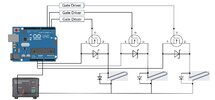kitstudent
New Member
Hi!
I have some general question about electronic components. I don't understand how or when they should be used, maybe someone can explain
Gatedriver and mosfet:
- when do I actually need a Gate Driver? As far as I understand it is used if the control device's output current or voltage is not high enough For (for example) the control of the mosfet with PWM from an arduino. So what and how excatly does the Gate Driver do? Increase current or voltage to the amount the mosfet requires?
Diodes:
- first of all whats the difference between flyback diode and TVS diode? I understand that both are used to protect from voltage spiked but when do I use a TVS and when a flyback?
- sometimes I see that a resistance is parallel to the device to be protected instead of a diode. Why is that so? A resistance would also decrease current right?
Thanks in advance!!
I have some general question about electronic components. I don't understand how or when they should be used, maybe someone can explain
Gatedriver and mosfet:
- when do I actually need a Gate Driver? As far as I understand it is used if the control device's output current or voltage is not high enough For (for example) the control of the mosfet with PWM from an arduino. So what and how excatly does the Gate Driver do? Increase current or voltage to the amount the mosfet requires?
Diodes:
- first of all whats the difference between flyback diode and TVS diode? I understand that both are used to protect from voltage spiked but when do I use a TVS and when a flyback?
- sometimes I see that a resistance is parallel to the device to be protected instead of a diode. Why is that so? A resistance would also decrease current right?
Thanks in advance!!


